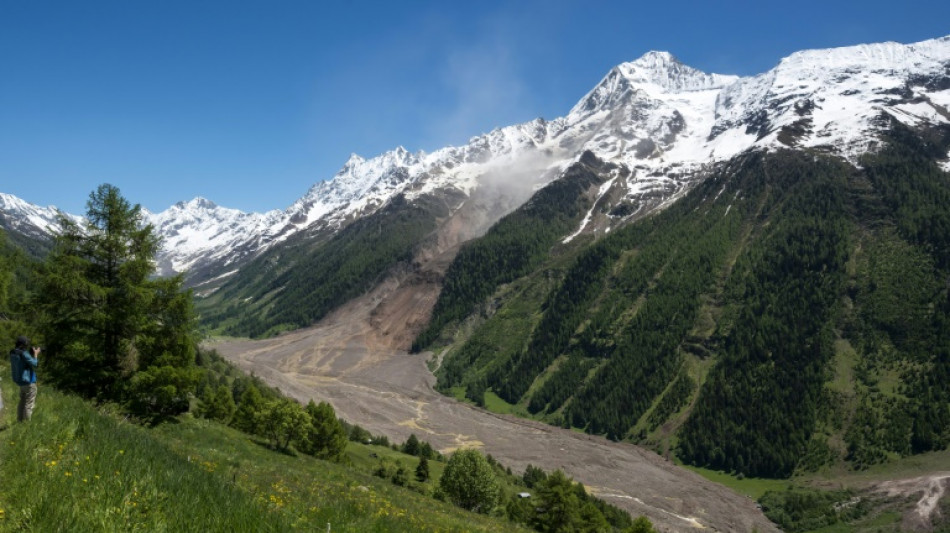
RYCEF
0.0800


A cascade of events in the Swiss Alps led to the dramatic collapse of the Birch glacier, wiping out Blatten village in the valley below, glaciologists and geoscientists told AFP on Friday.
Experts knew days ahead of Wednesday's landslide that the glacier was likely to suffer a catastrophic failure. But the reasons why date back much further.
There are strong theories on the causes, and to what degree the disaster is linked to climate change -- but these are yet to be confirmed by scientific analysis.
"This can be considered as a cascading event, because we have different processes involved," explained Christophe Lambiel, senior lecturer at the University of Lausanne's Institute of Earth Surface Dynamics.
- Mountain above the glacier -
The 3,342-metre (10,965-foot) high Kleines Nesthorn mountain above the glacier was already somewhat unstable, and rockfalls accelerated dramatically around 10 days beforehand.
Experts feared a total collapse within hours, but instead there were successive rockfalls over several days, which was actually the best-case scenario.
- Rockfall onto glacier -
Three million cubic metres of rock were deposited on the glacier.
"If you put a lot of weight on an unstable foundation, it can just slip away. And this is what actually happened," Matthias Huss, the director of Glacier Monitoring Switzerland (GLAMOS), told AFP.
"The glacier accelerated strongly in response to this additional loading, and then the disaster struck."
- The Birch glacier -
The Birch glacier was a special case: the only Swiss glacier that was advancing rather than shrinking. However, this was not because of extra snowfall.
Its advance "was quite likely due to the pre-loading with rockfalls from this mountain, which has finally collapsed. So the landslide didn't start from nothing," said Huss.
The glacier was on a steep slope, and even steeper at the front, worsening the dynamics.
Smaller-scale falls from the front of the glacier Tuesday were expected to continue, with Wednesday's sudden total collapse considered a less-probable scenario.
- How the glacier collapsed -
The rockfalls altered the stress equation between the weight of the glacier and the slope, which governs its forward speed, Lambiel told AFP.
Like pushing a car, it takes a lot of force to initiate movement, but less once it is on the move, he explained.
Huss said the 1,000 metres of elevation between the glacier and the Lotschental valley floor added a "huge amount of potential energy", which through friction melts part of the ice, making the fall "much more dynamic than if it was just rock".
- Role of melting permafrost -
Permafrost conditions are degrading throughout the Alps. Ice inside the cracks in the rocks has been thawing to ever-deeper levels over the last decade, especially after the summer 2022 heatwave.
"Ice is considered as the cement of the mountains. Decreasing the quality of the cement decreases the stability of the mountain," said Lambiel.
Huss added: "At the moment, we can't say it's because of permafrost thaw that this mountain collapsed -- but it is at least a very probable explanation, or one factor, that has triggered or accelerated this process of the mountain falling apart."
- Role of climate change -
Jakob Steiner, a geoscientist at the University of Graz in Austria, told AFP: "There is no clear evidence as of yet, for this specific case, that this was caused by climate change."
Huss said making such a direct link was "complicated".
"If it was just because of climate change that this mountain collapsed, all mountains in the Alps could collapse -- and they don't," he said.
"It's a combination of the long-term changes in the geology of the mountain.
"The failing of the glacier as such -- this is not related to climate change. It's more the permafrost processes, which are very complex, long-term changes."
Lambiel said of a link between climate change and the glacier moving forward over time: "Honestly, we don't know.
"But the increasing rockfalls on the glacier during the last 10 years -- this can be linked with climate change."
- Other glaciers -
Modern monitoring techniques detect acceleration in the ice with high precision -- and therefore allow for early warning.
Lambiel said around 80 glaciers in the same region of Switzerland were considered dangerous, and under monitoring.
"The big challenge is to recognise where to direct the detailed monitoring," said Huss.
Lambiel said sites with glacier-permafrost interactions above 3,000 metres would now need more research. But they are difficult to reach and monitor.
Steiner said: "Probably the rapidly changing permafrost can play some kind of role.
"This is concerning because this means that mountains are becoming a lot more unstable."
rjm-burs/phz/jhb
N.Wan--ThChM